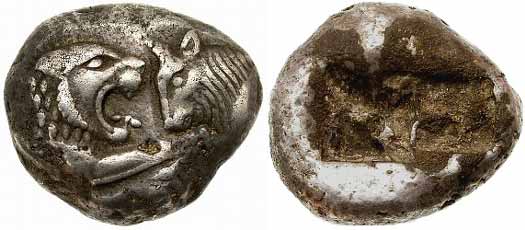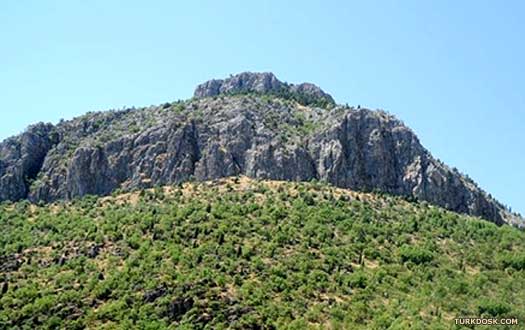
| PAMPHYLIA Situated in a rich, fertile alluvial plain on the modern Gulf of Antalya (opposite the north-western corner of Cyprus), the region known as Pamphylia lay between Lycia to the west and Cilicia to the east. It also extended a short way inland from the Mediterranean coast to Mount Taurus, where the pine forests of Pisidia bordered it. The rivers Kestros, Eurymedon, and Melas (the modern Aksu Çayi, Köprü Çayi, and Manavgat Çayi) all flowed into the sea through Pamphylia.
Following the end of Hittite control over central and southern Anatolia, any vestiges of the old administration which had formed the state of Tarhuntassa were entirely lost. Gradually settled by Æolian and Achaean Greeks over subsequent centuries, many areas retained their previous non-Hellenic languages (mostly Luwian or the pre- Indo-European languages of the earlier inhabitants). Either that or people learned to speak Greek with an accent. Similarly, the written language contained elements from Greek and native languages. Pamphylia's ruling structure between that Greek settlement period and its being conquered by Lydia remains unknown, as is mostly the case for its language. Even the origins of the name Pamphylia are unknown thanks to the uncertainty over language. Even if it had not been used before, Greek settlers of the seventh century made 'pam-phylos' popular (meaning 'all tribes' - although an alternative reading could produce 'pan' (all) plus 'philos' (brotherly love) - 'brotherly love for all'!). For these reasons it could be assumed that any ruling structure there was probably tribal in nature, without any large or powerful states being formed.
The Pamphylian city of Attalia (modern Antalya) lay close to the Lycian border (founded in 150 BC), while the city of Coracesium was situated perhaps a little too close to the rather uncouth inhabitants of Cilicia. Another town was Aspendus (modern Serik), which was believed to have been settled by Greeks from Argos in the century following the Trojan War (or by 'Argives', which can refer both to a citizen of the Greek city of Argos or a Greek combatant in the Trojan Wars). Also included in this list is Side, a port which became important under Roman control. Such Greek settlement of Pamphylia does seem possible, as part of a general trend of small groups of Greeks founding colonies around the southern and western Anatolian coast.
(Information by Peter Kessler, with additional information by Edward Dawson, from History of Humanity - Scientific and Cultural Development: From the Third Millennium to the Seventh Century BC (Vol II), Ahmad Hasan Dani, Jean-Pierre Mohen, J L Lorenzo, & V M Masson (Unesco 1996), from The Cities of the Eastern Roman Provinces, Arnold Hugh Martin Jones (1971), from the Encyclopaedia of the Roman Empire, Matthew Bunsen, from The Histories, Herodotus (Penguin, 1996), and from External Links: Livius.org, and The Geography of Strabo (Loeb Classical Library Edition, 1932).)
c.1183 BC :
Amphilochus : Son of Amphiaraus. Mythical leader of the Greek settlers.
c.1183 BC :
Calchas / Kalchas : Seer for Agamemnon of Mycenae.
c.1183 BC :
According to Herodotus and Strabo, the Argives Amphilochus and Calchas lead their Mycenaean followers to Pamphylia to settle there following the Trojan War. They found the town or Aspendus (modern Serik), situated on the banks of the River Eurymedon (where Athenian Admiral Cimon defeats the Persians in 465 BC). Amphilochus is a prominent seer, one who goes on to found several oracles, especially the one at Mallus in nearby Cilicia.
The Athenian politician and general Themistocles (archon in 493-492 BC) helped build up the city's navy so that it was a force to be reckoned with when the Persians invaded Greece - thanks to this the Athenian Admiral Cimon was able to defeat the Persians on the banks of the River Eurymedon in Pamphylia in 465 BC c.850 BC :
The
Luwian-speaking neo- Hittite state of Que forms close to Pamphylia's
eastern border, emerging in former south-western Kizzuwatna. The
kingdom flourishes in relative isolation until its conquest by Assyria
around 720 BC.
600s BC :
Greeks from the island of Rhodes enter the region of Pamphylia. They take the native tribal people to be the pam-phylos, the 'all tribes' of the region, and perhaps coin the name that is used by most subsequent Greek authors.
In the same century the Æolian Greek city of Cyme or Kyme is regarded as the most important of the twelve Æolian cities and can usually be located at Nemrut Limani ('limani' meaning 'port') in modern Izmir
on Anatolian Turkey's western coast. Settlers from Cyme found the colony and town of Side on a rocky promontory in Pamphylia, around ten kilometres west of the mouth of the River Melas. The settlement remains relatively isolated and, in time, loses its Greek language to a regionally-dominant Luwian-related dialect.
c.600 - 547 BC :
Coastal
Pamphylia is conquered by Lydia. The details are unknown but, by
the reign of Croesus from 560 BC, it certainly belongs to his kingdom.
The conquest is part of a process of expanding the kingdom in all
directions, which brings it into direct contact with Greek settlers
in western Anatolia. It is most likely King Sadyattes or his son,
Alyattes II, who are responsible for this rapid expansion.
547 - 334 BC :
King Croesus of Lydia has ambition that outruns his ability. He attacks the recently-established Persian empire and is defeated, being chased back to his capital, there to be captured. Lydia is absorbed into the empire and becomes the centre of a satrapy named Sparda. The empire of Croesus had included various neighbouring territories, including Pamphylia and Paphlagonia, and Persia takes these too.
Croesus was reputed to have minted the first gold and silver coins - two sides of such a silver coin are shown here - and was famous for his wealth until he became too ambitious and was conquered by the growing Persian empire 334 - 305 BC :
Pamphylia
is conquered by Alexander the Great's Greek empire. The isolated
settlement of Side is once again opened up to Greek influence, culture,
and language. Whatever remnant of Luwian that has been spoken here
since the sixth century BC quickly fades in favour of Greek.
A friend of Alexander, Nearchus is appointed satrap of Lycia and Pamphylia in 333 BC, being responsible for the ports in southern Anatolia. This forces the Persian navy to sail across open waters between Cyprus and the Aegean Sea. The Persian commanders Memnon of Rhodes and Pharnabazus are active in Aegean waters in 333 BC but receive no reinforcements, possibly due to Nearchus' efforts.
333 - 329 BC :
Nearchus / Nearkhos the Admiral : Also held Lycia. Recalled in 323 BC. Died c.300 BC.
329 - 323 BC :
Antigonus Monophthalmus (One Eye) : Satrap of Greater Phrygia. Also held Lycia.
329 - 301 BC :
Nearchus is recalled to Alexander's side in 329 BC. He brings with him reinforcements for the campaign in Persia and is accompanied by Asander, who becomes satrap of Caria in 323 BC. Nearchus' replacement as satrap is not recorded in history. Upon the death of Alexander, Pamphylia is absorbed into the Antigonid territories.
In 301 BC, Antigonus is killed and Pamphylia falls under the rule of the Lysimachian empire. With the struggle for dominance continuing between Alexander's generals, in 295 BC Pamphylia becomes part of the Ptomolaic kingdom, before falling to the Seleucid empire in 282 BC. It remains a Seleucid possession until 188 BC.
The route of Alexander's ongoing campaigns are shown in this map, with them leading him from Europe to Egypt, into Persia, and across the vastness of eastern Iran as far as the Pamir mountain range 188 - 129 BC :
The
Seleucids and Rome fight each other at the Battle of Magnesia ad
Sipylum in 190 BC. The Romans under Scipio Asiaticus win a resounding
victory, ending the Seleucid War. Anatolia (Asia Minor) is taken
as a Roman province in 188 BC. The Seleucid ally, Cappadocia, negotiates
friendly terms with Rome, but Lydia and Pamphylia are probably lost
to Pergamon at the same time, while Seleucid Lycia is awarded to
Rhodes.
During its domination by Pergamon, the region around Pamphylia becomes home to a nest of pirates, along with Cilicia and Pisidia, and the Pamphylian city of Side is transformed into a slave market. The eastern city of Coracesium largely becomes a pirate base. Pergamon founds one new city of its own in 150 BC - Attalia (modern Antalya), which lies close to the Lycian border.
129 BC :
Pergamon is defeated by a Roman army. The region becomes a province of Rome. The city of Side is still involved in piracy in the early first century, although Rome is reluctant to become involved until a change of mind in 78 BC. Previous defeats in half-hearted anti-piracy campaigns force a new direction being taken to solve the problem, but it still takes them until Pompey's victory of 67 BC to end regional piracy.
37 BC :
Amintas, tetrarch of the Trocmes and 'King of Galatia', already possesses Lycaonia, where Strabo relates that he 'maintained more than 300 flocks'. The territory of Derbe in Lycaonia is added to this, allegedly through the murder of its prince, Antipater of Derbe, the friend of Cicero (with the deed being alleged by Cicero himself). Isaura and Cappadocia are added as gifts from Rome. With Deiotarus now deceased, Amintas is made king of Cappadocia in 37 BC as a client ruler of Mark Anthony, and he subsequently bases himself in Pamphylia, which remains a possession only during his lifetime.
The conquest of the arid, mountainous Homonada region and the killing of its chieftain by Amintas led directly to the end of Galatian independence 11 BC :
Pamphylia provides urgently needed assistance to the Roman governor of Macedonia as he struggles to put down a four-year rebellion by the mountainous tribes of Thrace, most especially the powerful Bessoi. Now bolstered by reinforcements, the Romans manage to quell the revolting Bessoi by drowning the country in blood and fire.
By now the frequently lawless region of Pamphylia had already been a part of the province of Cilicia until 43 BC. Then it had been switched to the province of Asia, and in 31 BC Augustus had made it part of the province of Galatia. The future would hold further administrative changes (part of the province of Lycia and Pamphylia after AD 70, which would be divided in two in AD 314 or 325). Thereafter, Pamphylia follows the history of much of the rest of Anatolia, being part of the Eastern Roman empire and, ultimately, its successor, the Ottoman empire. Today it is part of modern Turkey.
Source :
https://www.historyfiles.co.uk/ |



